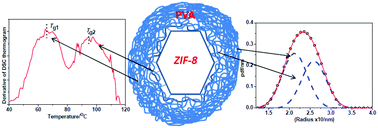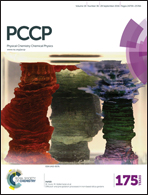Unraveling the sub-nanoscopic structure at interphase in a poly(vinyl alcohol)–MOF nanocomposite, and its role in thermo-mechanical properties†
Abstract
A microscopic model of the interfacial region is required to improve understanding of the role of local structure in bulk physical properties in metal organic framework-based polymer nanocomposites. A zeolitic imidazolate framework (ZIF-8)-based (loading 2–30 wt%) composite of poly vinyl alcohol (PVA) is studied as a model system to investigate the role of interfacial interaction in molecular packing, glass transition process and tensile properties. Attractive interfacial interaction between the surface of ZIF particles and PVA chains is established by Fourier transform infra red (FTIR) measurements. The morphology of the nanocomposites is characterized using X-ray diffraction and scanning electron microscopy (SEM), showing that aggregation of particles started from 5 wt% of ZIF-8. At low loadings, occurrence of two glass transitions measured using differential scanning calorimetry indicates two spatial zones, viz. interphase and bulk layers, of different packing density in the PVA matrix. With increase in loading, molecular packing throughout the polymer matrix is changed as the interparticle distance and interphase width become comparable. At the highest loading, PVA shows bulk glass transition temperature because of the non-significant volume fraction of interphase resulting from aggregation of ZIF. Molecular packing (free volume structure) of PVA in the nanocomposites is investigated using ortho-positronium lifetime distributions, which show that large vacant spaces are created at the interfacial region leading to a low-density interphase. The existence of a low-density interphase is also supported by bulk-density measurements of the nanocomposites. Tensile testing measurements show a decrease in ductility of the nanocomposites, indicating enhancement in rigidity of polymer chains at the interfacial region because of attractive interfacial interaction. This study indicates that the polymer chain framework at the interfacial region in PVA–MOF nanocomposites can be represented by a rigid but rather open network.


 Please wait while we load your content...
Please wait while we load your content...